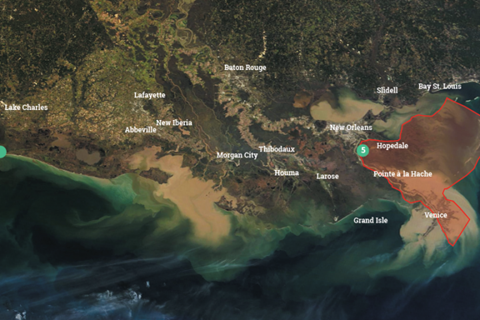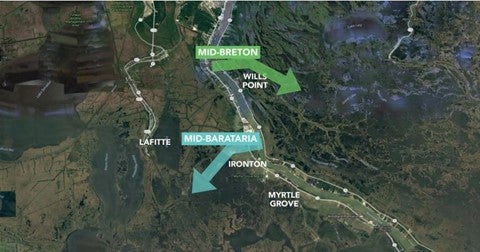A View from Above: Mid-Breton Sediment Diversion is crucial to Louisiana’s future
The scale of Louisiana’s land loss crisis – and the work being done to preserve it – can be hard to grasp from the ground. One of the best education and advocacy tools for coastal restoration is to fly people over the coast to see the scale and impacts of our land loss crisis. While we can’t bring everyone up on a plane, we can do our best to bring that perspective to you here. In this blog series, we are following a virtual flyover path down the lower Mississippi River and looking at past and future projects impacting our coastline. Check out the other posts in this series.
Howdy, and welcome back to your flight across Louisiana’s coast!
As we move along on our flight, we must make a stop at another vital restoration project along the Mississippi River: The Mid-Breton Sediment Diversion.
The Mid-Breton Sediment Diversion is a key project proposed from the previous year’s Coastal Master Plan, intended to reduce land loss in the Breton Basin and will be located on the east bank of the Mississippi River at Wills Point in Plaquemines Parish. Sediment diversions use the power of the Mississippi River to move sediment and fresh water from the river into nearby basins, mimicking nature’s historic land-building processes. These projects not only build new land but also provide an ongoing source of sand and mud necessary to sustain and increase the health of existing wetlands over time.

The Breton Basin is losing land daily, leaving communities from Pointe a la Hache to New Orleans increasingly vulnerable to storm surge. The Mid-Breton Sediment Diversion will have major implications for Louisiana’s coast and communities and aims to deposit fresh sediment into marshes that have been sediment-starved since levees were built almost 100 years ago. The diversion will build and maintain thousands of acres of new land in the Breton Basin during its first 50 years of operation, making it an essential project that restores land, sustains vital ecosystems and protects local communities.
Below you can watch local leader Albertine Kimble talk about how important the Mid-Breton Diversion is to the area.
This diversion will complement other projects in the basin, such as the Pointe a la Hache and Carlisle Marsh Creation Project, by helping supplement the new wetlands with life-giving waters from the Mississippi River, extending the lifespan of this and other nearby projects. The addition of sediment and nutrients from the river will gradually increase soil strength, improving the marshes in the basin. The sediment diversion will help restore Breton Basin’s health, providing a stronger habitat for wildlife, such as deer, wintering ducks, alligators, largemouth bass and crawfish. These wetlands also provide an important line of defense against storm surge for local communities and the New Orleans metro region.

The Mid-Breton Diversion is part of CPRA’s Mid-Basin Sediment Diversion Program, which includes the larger Mid-Barataria Sediment Diversion. Both of these projects were developed and funded through Louisiana’s Coastal Master Plan, which serves as a guide for Louisiana’s coastal restoration. Released every six years, the plan uses the most up-to-date science and planning to determine the best way to spend the state’s resources over the next 50 years as we face the challenges of land loss, climate change and sea level rise. You can see the scope of the 2023 Coastal Master Plan by using CPRA’s Master Plan Data Viewer.
As we fly onward to the next stop in this series, please note that as Mid-Barataria advances through the implementation process ahead of Mid-Breton, it will provide lessons learned for this similar though slightly smaller project.
Until next time!